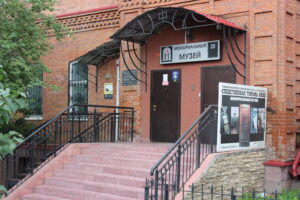Just a brief post, but I wanted to highlight a recent exhibition at the NKVD Remand Prison Museum in Tomsk (44 Lenin Avenue), on the 30th anniversary of the local authorities’ decision to designate space to help perpetuate the memory of Stalinist repression, a decision that led to the founding of the Museum. Follow the link to the museum’s website for photos of the exhibit. The date was 13 June 1989, a period of intense changes in the Soviet Union. Despite the changes, the Tomsk decision was a bold one, and the Tomsk museum was, along with the Perm’-36 museum, essentially the first in Russia dedicated to issues related to the Gulag and repression. You can find out a bit more about the founding of the museum, and the placing of the “sorrow stone” in the adjacent square, in my chapter in the Russia’s Regional Identities book. Here’s a photo I took of the Museum’s entrance in the summer of 2016.

Museum Entrance (photo by W. Bell)
